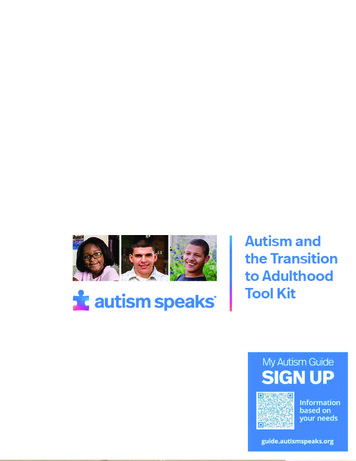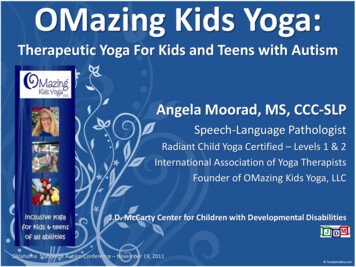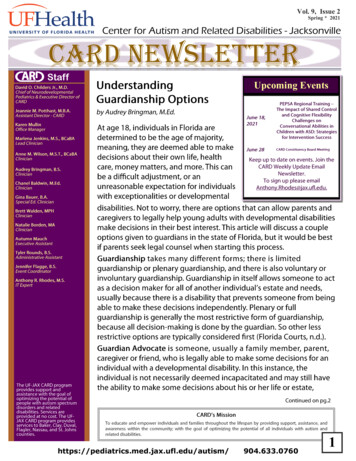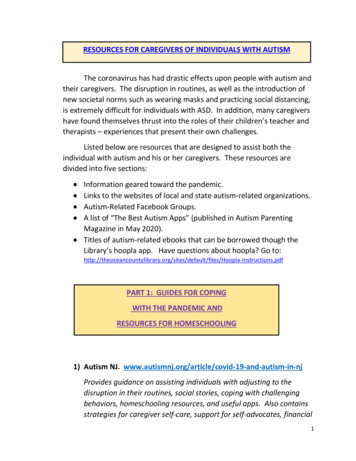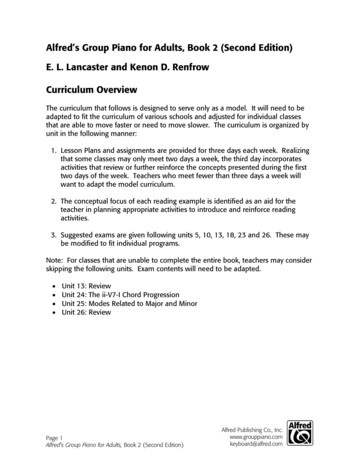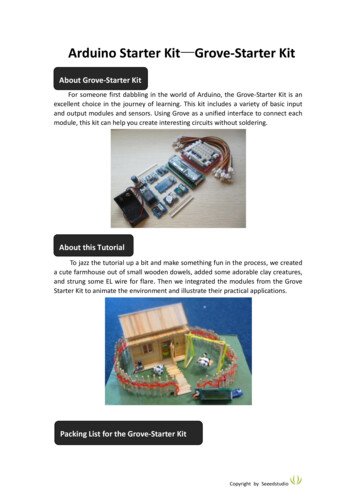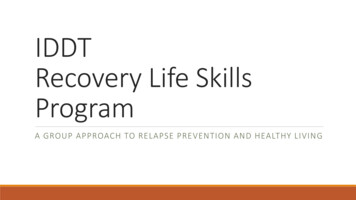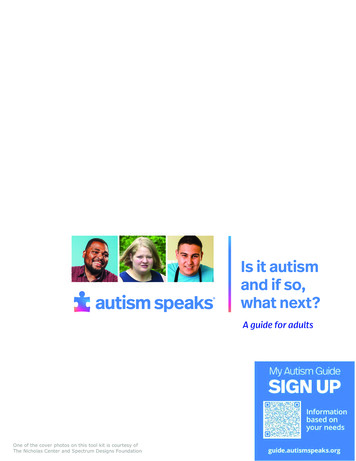
Transcription
Is it autismand ififso,so,what next?AA guideguideforforadultsadultsOne of the cover photos on this tool kit is courtesy ofThe Nicholas Center and Spectrum Designs Foundation
IS IT AUTISM? A GUIDE FOR ADULTSAbout This KitIs It Autism and If So, What Next? A Guide for Adultsis a tool designed to help assist adults who suspectthey may have autism, as well as those who havebeen recently diagnosed with the disorder.This tool kit was released in the spring of 2015. Itwas created by the Autism Speaks Family Servicesstaff, in conjunction with a group of contributorsmade up of adults with autism and other professionals, as well as the Family Services Committee.AcknowledgementsAutism Speaks would like to extend special thanksto those who contributed to the kit for their timeand effort:AUTISM SPEAK FAMILY SERVICESCOMMITTEEAmit BasakParentLiz BellParentSallie Bernard*Parent, Executive Director, SafeMindsCuong Do*ParentPeter Faustino, Psy.D.New York Association of School PsychologistsPeter F. Gerhardt, Ed.D.Former President, Organization for Autism Research(OAR)Mel Karmazin*GrandparentCONTRIBUTORSBrian Kelly * **ParentDavid Beversdorf, Ph.D.Thompson Center for Autism andNeurodevelopmental DisabilitiesGary S. Mayerson*Founding Attorney, Mayerson & AssociatesArtie Kempner*ParentMegan Farley, Ph.D.Waisman Center for Developmental DisabilitiesLinda Meyer, Ed.D., MPA, BCBA-D, CPTAutism ConsultantEric KirschnerKerry MagroPaul NussbaumValerie Paradiz, Ph.D.David PowellSamantha RanaghanStephen Shore, Ed.D.Jeremy Sicile-KiraJohn TaylorSondra WilliamsGillian WilsonKevin Murray*ParentDanny Openden, Ph.D., B.C.B.A.-D.President and CEO, Southwest Autism Research andResource Center (SARRC)Valerie Paradiz, Ph.D.Director, Valerie Paradiz, LLCDirector Autistic Global Initiative, Parent, Self-advocateLori RicklesParentStuart Savitz*ParentPaul Shattuck, Ph.D.Leader, AJ Drexel Autism Institute Research ProgramArea on Life Course Outcomes*Autism Speaks board member**Chairperson – Family Services CommitteeParent – indicates a parent of a child with autismStephen Shore, Ed.D.Assistant Professor, Special Education, AdelphiUniversityMichelle SmigelParent
Is iT autism? a guide for adultsIt’s time to listen.A tool kit for adults who suspect they may haveautism, as well as those who have been recentlydiagnosed with the disorder.Autism Speaks does not provide medical or legal advice or services. Rather, Autism Speaks providesgeneral information about autism as a service to the community. The information provided in this tool kitis not a recommendation, referral or endorsement of any resource, therapeutic method, or serviceprovider and does not replace the advice of medical, legal or educational professionals. Autism Speakshas not validated and is not responsible for any information or services provided by third parties. You areurged to use independent judgment and request references when considering any resourceassociated with the provision of services related to autism. 2015 Autism Speaks Inc., Autism Speaks, and Autism Speaks It’s Time to Listen & Design, as well as Autism Speaks Light It Up Blue, are registered trademarks owned by Autism SpeaksInc. All rights reserved. The use of these trademarks by unaffiliated representatives for endorsement, advertising, promotional, and sales materials is prohibited by law.
IS IT AUTISM? A GUIDE FOR ADULTSTable of ContentsIntroductionWhat is Autism?What are the Symptoms of Autism?Strengths and Challenges by Stephen ShoreMedical and Psychiatric Issues that May Accompany AutismHow Do I Get a Diagnosis?9111213From Denial to Acceptance: I Was Diagnosed with Autism at 241516Disclosure To Tell or Not to Tell?ConclusionGlossaryResources56My Story: Diagnosed with Autism at 34What Are My Rights?3Why Do I Need a Diagnosis?How is Autism Treated?118192024
Is it autism? a guide for adultsIntroductionYou have downloaded or ordered this tool kit because you suspect you mayhave autism or you’ve received a new diagnosis as an adult. You have cometo the right place!As autism awareness has grown dramatically in recent years, many youngadults and adults have learned the signs and felt there may be a connectionbetween their feelings and behaviors and the symptoms of autism. For some,it can come as a relief as questions they’ve had for many years may finallyhave an answer. Many have been misdiagnosed with other conditions or werenever able to get a formal diagnosis of a condition or disorder that explainstheir symptoms.This kit will provide an overview of autism to help you better understand thedisorder and will hopefully clarify whether you should seek out a professionalfor a thorough evaluation. If/When you are in fact diagnosed with autism, thekit will also walk you through next steps in terms of accessing services andprovide you with critical information about your rights and entitlements as anadult on the spectrum. There is also a list of helpful resources for you to findmore information about next steps for the days and months following yourdiagnosis.If you have any additional questions or are looking for resources, the AutismSpeaks Autism Response Team (ART) is here to help! ART coordinatorsare specially trained to help support the autism community by answering callsand emails and by providing guidance and information. The Autism ResponseTeam can be reached by email at familyservices@autismspeaks.org or byphone at 888-288-4762 (en Español at 888-772-9050).Let’s get started!
Is it autism? a guide for adultsWhat is Autism?Autism spectrum disorder (ASD) and autismare both general terms for a group of complexdisorders of brain development characterized, invarying degrees, by difficulties in social interaction,verbal and nonverbal communication andrepetitive behaviors. Though there are strengthsand unique abilities associated with the disorder,autism is most often defined based on “deficits”and “symptoms” because the definition from theAmerican Psychiatric Association’s Diagnosticand Statistical Manual of Mental Disorders(DSM) is science-based and the manual is used todescribe disorders for diagnosis. With the May 2013publication of the fifth edition of the DSM (commonlyreferred to as the DSM-5), all autism disorderswere merged under one umbrella diagnosis ofASD. Previously, they were recognized as distinctsubtypes, including autistic disorder, childhooddisintegrative disorder, pervasive developmentaldisorder-not otherwise specified (PDD-NOS)and Asperger Syndrome. Individuals with wellestablished diagnoses of these disorders prior to thepublication of the DSM-5 should now be given thediagnosis of autism spectrum disorder.Under the current DSM-5, there are two domainswhere people with ASD must show persistentdeficits. They include: stereotyped or repetitive motormovements insistence on sameness or inflexibleadherence to routines highly restricted, fixated interests hyper- or hypo-reactivity to sensoryinput or unusual interest in sensoryaspects of the environmentThe DSM-5 also added an additional category calledSocial Communication Disorder (SCD). This allowsfor a diagnosis of disabilities in social communication,without the presence of repetitive behavior. SCDis a new diagnosis and much more research andinformation is needed to better understand it. Thereare currently few guidelines for the treatment of SCD.Until such guidelines become available, treatmentsthat target social-communication, including manyautism-specific interventions, should be provided toindividuals with SCD.1. persistent social communication andsocial interaction2. restricted and repetitive patterns of behaviorMore specifically, people with ASD must demonstratedeficits (either in the past or in the present) in socialemotional reciprocity, nonverbal communicativebehaviors used for social interaction, as well asdeficits in developing, maintaining and understandingrelationships. In addition, they must show at least twotypes of repetitive patterns of behavior including:To read the whole DSM-5 criteria, please visitautismspeaks.org/dsm-5.1
Is IT auTIsm? a guIde for adulTsHow Common is autism?While no studies have been able to confirm theprevalence rate for adults and more research isneeded, autism statistics from the U.S. Centers forDisease Control and Prevention (CDC) released inMarch 2014 identify around 1 in 68 American childrenas on the autism spectrum – a ten-fold increase inprevalence in 40 years. Careful research shows thatthis increase is only partly explained by improveddiagnosis and awareness. Studies also show thatautism is four to five times more common amongboys than girls. An estimated 1 out of 42 boys and1 in 189 girls are diagnosed with autism in theUnited States.“Half my life was a long hard strugglewhere ‘I was not playing with a full deck’ interms of negotiating the world before mydiagnosis. After my diagnosis, ‘the lightbulb went on’ and I found a huge population just like me with the same struggles.At this point, my life started falling intoplace and over time, after my diagnosis,I gained a much better understanding ofmyself and the world around me.”ASD affects over 2 million individuals in the U.S.and tens of millions worldwide. Government autismstatistics suggest that prevalence rates haveincreased 10 to 17% annually in recent years.There is no established explanation for thiscontinuing increase, although improved diagnosisand environmental influences are two reasonsoften considered.What Causes autism?- Paul NussbaumNot long ago, the answer to this question would havebeen, “we have no idea.” Research is now startingto deliver the answers. First and foremost, we nowknow that there is no one cause of autism, just asthere is no one type of autism. Over the last fiveyears, scientists have identified a number of raregene changes or mutations associated with autism.Research has identified more than 100 autism riskgenes. In around 15% of cases, a specific geneticcause of a person’s autism can be identified.However, most cases involve a complex and variablecombination of genetic risk and environmental factorsthat influence early brain development. In otherwords, in the presence of genetic predisposition toautism, a number of non-genetic or environmentalinfluences further increase an individual’s risk.Some factors that have been identified to increasethe risk of autism include parental age, extremeprematurity, difficulties during birth, mothers exposedto high levels of pesticides and air pollution. Itis important to keep in mind that these factors,by themselves, do not cause autism. Rather, incombination with genetic risk factors, they appear tomodestly increase risk.2
Is it autism? a guide for adultsWhat are the Symptomsof Autism?Autism affects the way an individual perceivesthe world and makes communication and socialinteraction different from those without autism, oftenleading to significant difficulties. ASD is characterizedby social-interaction challenges, communicationdifficulties and a tendency to engage in repetitivebehaviors. However, symptoms and their severityvary widely across these three core areas.“It is sometimes said that if you know one personwith autism, you know one person with autism.”Repetitive behaviorsUnusual repetitive behaviors and/or a tendency toengage in a restricted range of activities are anothercore symptom of autism. Some repetitive behaviorsinclude arranging and rearranging objects or handflapping. Some people with autism are preoccupiedwith having household or other objects in a fixedorder or place. It can prove extremely upsetting ifsomething or someone disrupts the order. Many needand demand strict consistency in their environmentand daily routine. Slight changes can be exceedinglystressful and lead to outbursts.- Stephen ShoreSocial symptomsIndividuals with autism tend to have difficultyinterpreting what others are thinking and feeling.Subtle social cues such as eye rolling, shouldershrugging or a grimace may convey little meaning tosome people on the spectrum. Without this ability toaccurately interpret gestures and facial expressions,or nonverbal communication, the social world canseem bewildering.Repetitive behaviors can also take the form ofintense preoccupations or obsessions. Theseextreme interests can prove all the more unusualfor their content (e.g. machines, certain collectibles)or depth of knowledge (e.g. knowing and repeatingastonishingly detailed information about astronomy).Adults with autism may develop tremendous interestin numbers, symbols, dates or science topics. Someof these interests can be a great asset in somecircumstances, like employment, when harnessed ina productive way.Many people with autism have similar difficultyseeing things from another person’s perspective.This, in turn, can interfere with the ability to predictor understand another person’s actions. It is alsocommon – but not universal – for those with autism tohave difficulty regulating emotions.Communication difficultiesAt an early age, many children with autismexperience significant language delays. However,some exhibit only slight delays or even developprecocious language and unusually largevocabularies – yet have difficulty sustainingconversations. Some children and adults with autismtend to carry on monologues on a favorite subject,giving others little chance to comment. In otherwords, the ordinary “give-and-take” of conversationproves difficult.3
Is IT auTIsm? a guIde for adulTsexecutive Functioning and Theoryof MindIndividuals with autism often face challenges relatedto their ability to interpret certain social cues andskills. They may have difficulty processing largeamounts of information and relating to others. Twocore terms relating to these challenges are executivefunctioning and theory of mind.Executive functioning includes skills such asorganizing, planning, sustaining attention andinhibiting inappropriate responses. Difficulties in thisarea can manifest themselves in many different ways.Some may pay attention to minor details, but in turnstruggle with seeing how these details fit into a biggerpicture. Others have difficulty with complex thinkingthat requires holding more than one train of thoughtsimultaneously. Others have difficulty maintainingtheir attention or organizing their thoughts andactions. Individuals with autism often face challengesusing skills related to executive functioning likeplanning, sequencing and self-regulation.“I’m proud to say I have autism, as it hashelped shape the man I am today. I havegenuine confidence in myself and I knowthat others out there like me can achieveanything they set their minds to. I trulybelieve that people on the spectrum aresome of the brightest individuals in oursociety and can offer so much in theworkforce and in life.”- Eric KirschnerTheory of mind can be summed up as a person’sability to understand and identify the thoughts,feelings and intentions of others. Individualswith autism can encounter degrees of difficultyrecognizing and processing the feelings of others,which is sometimes referred to as “mind-blindness.”As a result, people with autism may not realizeif another person’s behaviors are intentional orunintentional. This challenge often leads others tofalsely believe that the individual does not showempathy or understand them, which can creategreat difficulty in social situations.4
Is it autism? a guide for adultsStrengths and Challengesby Dr. Stephen Shore, Ed.D., Self Advocate, Authorand Assistant Professor at Adelphi UniversityWhile some symptoms of autism discussed above may present challenges, others canbe great strengths and advantages for people on the spectrum.In the piece below, self-advocate and university professor Dr. Stephen Shore shares a list ofstrengths and challenges for those with autism. It is important to note that this is a generallist. For every strength and challenge, you will often find examples in people that prove theopposite. For example, clumsiness is a common challenge. However, some with autism havesignificant strengths in movement and balance, perhaps as a dancer.StrengthsChallengesAttention to detailGrasping the big pictureOften highly skilled in a particular areaUneven set of skillsDeep study resulting in encyclopedicknowledge on areas of interestTendency to be logical (helpful in decisionmaking where emotions may interfere)Less concern for what others may think ofthem (can be a strength and a challenge),also known as independent thinking. Oftenresults in novel “big picture” insights due todifferent ways of looking at things, ideasand concepts.Usually visual processing (thinking inpictures or video)Often very verbal (propensity for givingdetailed descriptions may be useful inproviding directions to lost persons)Difficulty developing motivation to study areasof non interestDifficulty perceiving emotional state of othersDifficulty perceiving unwritten rules of socialinteraction, but can learn these rules throughdirect instruction and social narratives such asPower Cards (Gagnon, 2004)Difficulty processing in non-favorite modalitiessuch as aural, kinesthetic, etc.Difficulty parsing out and summarizingimportant information for a conversationDirect communicationSensory integration problems where inputmay register unevenly, distorted and difficultyin screening out background noiseLoyaltyGeneralization of skills and conceptsDifficulty in expressing empathy in ways thatothers expect or understandExecutive functioning resulting in difficultitesplanning long-term tasksHonestyNonjudgemental listening5
Is IT auTIsm? a guIde for adulTsmedical and PsychiatricIssues that may accompanyautismMany children and adults diagnosed with autism haveadditional medical issues, including epilepsy, sleepdysfunction, gastrointestinal disorders or geneticdisorders like Fragile X syndrome. As an adult, youmay not have experienced these conditions thatoften arise at a very young age. But in addition tothese disorders, many individuals with autism alsohave a variety of psychiatric and mental healthchallenges. Some research suggests that autismshares a genetic basis with several major psychiatricdisorders, including attention deficit and hyperactivitydisorder (ADHD), depression, bipolar disorder,anxiety and schizophrenia.“My anxiety can be so profound becauseof the fear of social expectations, sensoryviolations and unexpected changes.These are all so unbearable that I canfeel frozen and unable to move forward.A simple request of me can sometimes bethe core trigger of a meltdown.”It is important to note that while some researchsuggests that just over two-thirds of children withautism have been diagnosed with one or morepsychiatric disorders, healthcare professionals notfamiliar with autism tend to over-diagnose psychiatricproblems in this group. This may be due to overlapbetween autism symptoms and those associated withpsychiatric disorders. It is critical to receive accuratediagnoses of these conditions because medicationor therapy to treat them may significantly improveautism symptoms and quality of life.- Sondra WilliamsanxietyRecent studies suggest that 30% of individuals withautism struggle with an anxiety disorder such associal phobia, separation anxiety, panic disorderand specific phobias. Some experts suspect thatoutward symptoms of anxiety – such as swearingand acting out – may be especially prominent amongpeople on the spectrum. Even in the absence of ananxiety disorder, many individuals with autism havedifficulty controlling anxiety when something triggersit. Anxiety can range from occasional, mild andcompletely understandable to unremitting, severeand irrational.This section contains more information aboutsome of these challenges faced by individualson the autism spectrum.6
IS IT AUTISM? A GUIDE FOR ADULTSThe Food and Drug Administration (FDA) hasnot approved any medication expressly for thetreatment of anxiety in persons with autism, howeversome drugs approved to treat anxiety disorders inthe general population are commonly used to helpindividuals with autism, such as Prozac and Zoloft.Medicines for relieving anxiety are best used incombination with counseling or other behavioralinterventions. Individuals with autism may respondbest to tailored treatments specific to those withboth diagnoses.If you suspect you may have an anxiety disorder, askyour doctor for recommendations for mental healthprofessionals who may specialize in treating anxiety.“I suffer from anxiety and depression, so fora long time my ‘strangeness’ was attributedto these conditions. Since my diagnosis, Ifeel more in control now. I am in charge ofmy life and destiny. I feel that even thoughautism has its challenges, I have beenmore blessed than anything else.”Attention Deficit Hyperactivity Disorder(ADHD)According to the National Institute of Mental Health(NIMH), ADHD affects about 4.1% of American adultsage 18 and older and 9.0% of American childrenage 13 to 18. Those rates are estimated to be muchhigher among the autism population as many childrenand adults with autism struggle with ADHD. Whilethere has not been a study on ADHD specificallyamong adults, recent studies suggest that 1 in 5children on the spectrum also has ADHD. Anotherstudy found that just 1 in 10 children diagnosed withboth autism and ADHD was receiving medication torelieve the ADHD symptoms, as many symptomscan likewise result from autism.- G.W.meals, class or other activities. Impulsivity, a thirdhallmark of ADHD, can cause an individual to bevery impatient, blurt out inappropriate comments, actwithout regard to consequences and have difficultyshowing his or her emotions without restraint.According to NIMH, inattention, hyperactivityand impulsivity are the key behaviors of ADHD.Inattention can result in individuals being easilydistracted and having difficulty focusing on onething, processing information, listening and followingdirections. Sometimes ADHD can go undiagnosedif symptoms are viewed as emotional problems,challenging behaviors or difficulties at school andin the workplace. Symptoms of hyperactivity mayinclude fidgeting and squirming, difficulty with quiettasks or activities and trouble sitting still duringIf you suspect you may have ADHD, it is importantto be evaluated by a licensed mental healthprofessional because treatment of the disorder,which often involves medication, can be very helpfulin correcting these symptoms. To be diagnosedwith ADHD as an adult, you must have symptomsthat began in childhood and continued throughoutadulthood. For some adults, a diagnosis can bring asense of relief as it can help explain behaviors thathave been present for most of their lives.7
Is it autism? a guide for adultsDepression/Bipolar DisorderIndividuals with autism may be particularly proneto depression, another disorder of the brain, inadolescence and adulthood. It can be difficult todiagnose, however, because many people on thespectrum are less likely to communicate the feelingsused to diagnose depression. Seeing a mental healthprofessional who has experience with autism is veryimportant when seeking a depression diagnosis.Many people with depression never seek treatment,but when diagnosed properly, both cognitivebehavioral therapy and medications can significantlyimprove the individual’s feelings. If you feel youmay be depressed, learn more about the signsand symptoms from the National Institute of MentalHealth and ask your doctor for a referral to a mentalhealth professional.Bipolar disorder, once commonly called manicdepression, involves episodes of abnormally highenergy alternating with depression over a period oftime. Among individuals with autism, the symptomsof bipolar disorder commonly include abruptincreases in “pressured speech”, pacing, impulsivity,irritability and insomnia. Some studies have foundthat as many as 27% of those with autism may havebipolar disorder, compared to its prevalence in thegeneral population of around 4%. Psychiatrists oftenprescribe psychoactive medications to treat bipolardisorder. Studies suggest that mood-stabilizingmedications may be safer treatments for thosewith autism.8
Is IT auTIsm? a guIde for adulTsThis sounds familiar Now How do I get adiagnosis?Obsessive-Compulsive DisorderDoctors or therapists unfamiliar with autism oftenmistake some of autism’s core symptoms likerepetitive behaviors and restricted interests withthose of obsessive-compulsive disorder (OCD).But it is important to distinguish between the two. Adistinguishing hallmark of OCD is that the compulsivethoughts or behavior cause anxiety. By contrast,persons with autism are not generally bothered bytheir repetitive behaviors and restricted interests,which tend to bring them comfort and enjoyment.The estimated prevalence of OCD in those withASD ranges from 8 to 33% depending on the study,compared to the general population prevalenceof 2%. For an OCD diagnosis, it is important thatthe mental health professional has knowledge ofautism and its symptoms. As is the case with otherdisorders, a combination of medication and cognitivebehavioral therapy can significantly improve thesymptoms of OCD.If you feel you might have autism, it is important tofind a mental health professional with experiencediagnosing the disorder, preferably in other adults.Bring your concerns to your general practitionerand ask for recommendations for a psychiatrist,psychologist or social worker who can help you. Itmay help to bring a list of the symptoms of autismyou feel you may have, including examples ofsome of the behaviors and feelings that triggeryour concerns. You can also try searching theAutism Speaks Resource Guide for mental healthprofessionals in your area atautismspeaks.org/resource-guide. While some mayonly diagnose children, they may be able to point youin the right direction.Sensory Integration DysfunctionMany individuals with autism experience unusualresponses to sensory stimuli or input due todifficulty in processing and integrating sensoryinformation. Vision, hearing, touch, smell, taste,the sense of movement and the sense of positioncan all be affected, meaning while informationis sensed normally, it may be perceived muchdifferently. Stimuli that seem “normal” to otherscan be experienced as painful, unpleasant orconfusing by an individual with autism. SensoryIntegration Dysfunction (SID), the clinical termfor this characteristic, can involve hypersensitivity,such an ability to tolerate being touched, orhyposensitivity, such as an increased tolerancefor pain or constant need for sensory stimulation.Treatment is usually addressed with sensoryintegration therapy, which is provided by certifiedoccupational and physical therapists.“Autistic people like me have many sensoryprocessing issues that stand in the way ofbeing flexible. People with autism can beextremely sensitive to noise, lights, smells andmany times touch. I need direct instructionabout what the rules of expected behavior arein the different environments. Kind are thosewho are truly patient.”- Jeremy Sicile-Kira9
Is IT auTIsm? a guIde for adulTsHow Do I Get Evaluated as an Adult If I Suspect I Have Autism?by David Beversdorf, Ph.D., neurologist at the University ofMissouri’s Thompson Center for Autism and Neurodevelopemental DisabilitiesWith awareness of autism so high today, it’s no longeras common for an autism diagnosis to be overlookedin childhood. However, this wasn’t always the case.As a result, it’s not infrequent that I see teens andadults seeking a diagnosis.Evaluating autism in a previously undiagnosedadult can be challenging. And yes, it’s true that thestandardized diagnostic checklists we commonly useare designed for children. There are no establisheddiagnostic tests for ASD in adults. However, I’m gladto report that they are currently in development.Conducting an Adult Evaluationdiagnosis. Clearly, this is not possible when thereisn’t an older relative available for a reliable report.Because of these limitations, the evaluation of anadult has to lean heavily on direct observation. Thiswill be in the context of a discussion between theclinician and the patient about current challenges inthe areas of social interaction and communication,sensory issues and restricted interests or repetitivebehaviors.Sometimes, a person’s early development did nothave any features suggestive of autism. Instead, theybegan struggling with social withdrawal and relatedissues in their teens or adulthood. This suggests acognitive or mental health issue other than ASD.Finding Someone Qualified to EvaluateAdults with ASDHowever, some higher functioning adults on theautism spectrum become very resourceful indeveloping strategies to compensate for theirdisabilities. Clearly, this makes a diagnosis basedon observation much more difficult. But diagnosisremains important even when for those who havelearned to hide their symptoms because they maystill struggle in their everyday lives and interactions.Currently, there are relatively few clinicians whospecialize in evaluating and treating adults withautism. Nor do we have established criteria toobjectively judge such qualifications.In my opinion, your best bet may be a developmentalpediatrician, child psychiatrist or pediatric neurologistwho is both experienced in evaluating autism inchildren and open to seeing older patients. If she orhe does not feel qualified to evaluate an adult, he orshe may have a respected colleague who would be.In these cases, it’s important to explore the lifelongpresence of related developmental issues. In particular, it’s critical to get detailed information aboutearly childhood. Sometimes this clearly reveals anearly development that fits with a diagnosis of ASD.Otherwise I would recommend contacting anestablished and respected autism center in your area.Examples include the centers in the Autism SpeaksAutism Treatment Network. To locate an AS-ATNnear you, visit autismspeaks.org/ATN. This willprovide you with the assurance that the clinician hasagreed to adhere
Is it autism and if so, what next? A guide for adultsA guide for adults Is it autism and if so, One of the cover photos on this tool kit is courtesy of
